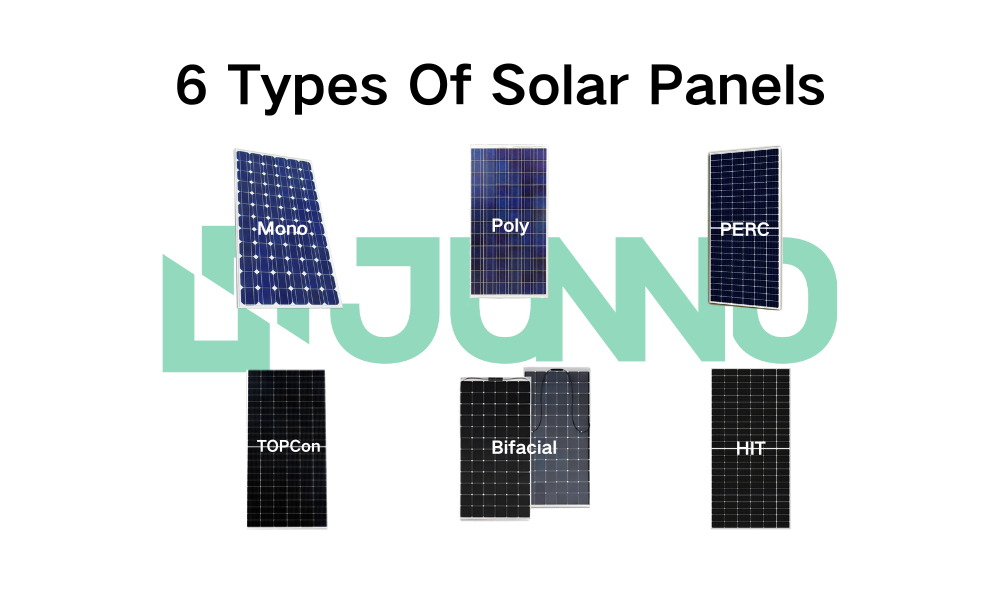6 Types Of Solar Panels: Which One Is The Best Choice?
6 types of solar panels
Monocrystalline Solar Panels
Monocrystalline silicon solar cells are made of extremely pure monocrystalline silicon. They have the highest conversion efficiency and the most mature technology.
Advantages: The conversion efficiency typically ranges from 15% to 24%. The manufacturing process is mature and stable, and the uniform structure of monocrystalline silicon, along with its low levels of impurities and defects, contributes to the high conversion efficiency of the cells.
Disadvantages: The production cost is relatively high.
Applicable scenarios: Residential rooftops, commercial projects, and areas with limited space.
Polycrystalline Solar Panels
The manufacturing process of polycrystalline silicon solar panels is quite similar to that of monocrystalline silicon solar panels, consisting of multiple small polycrystalline silicon blocks.
Advantages: The production cost is lower than that of monocrystalline silicon solar panels, the material manufacturing process is simpler, and it saves on electricity consumption.
Disadvantages: Conversion efficiencies are slightly lower than monocrystalline silicon panels, typically between 13% to 17 %, and life spans are shorter than monocrystalline silicon solar panels.
Applicable scenarios: Projects with limited budgets and large-scale ground power stations.
PERC Solar Panels
PERC solar panels, also known as Passivated Emitter and Rear Cell, incorporate two additional processes to the traditional BSF (Back Surface Field) cells: rear surface passivation and laser opening. These enhancements significantly improve the conversion efficiency and overall performance.
Advantages: The conversion efficiency is approximately 23%. As the current mainstream technology, it holds the highest market share. The structure is simple, the process flow is short, and the equipment maturity is high.
Applicable scenarios: High-efficiency residential and commercial projects.
TOPCon Solar Panels
TOPCon cells are also a popular high-efficiency battery technology, featuring the preparation of an ultra-thin tunneling oxide layer and a highly doped polysilicon layer on the back of the cell to form a passivated contact structure.
Advantages: The conversion efficiency can reach 24% - 25%. Production can be achieved by upgrading and retrofitting existing PERC production lines, offering good production line compatibility. They exhibit excellent stability and reliability, with stable long-term power generation performance.
Applicable scenarios: High-efficiency residential and commercial projects, and scenarios with high demands for efficiency.
Bifacial Solar Panels
Bifacial solar panels are an innovative product designed to capture sunlight from both the front and back sides, thereby maximizing energy yield.
Advantages: The average conversion efficiency of the front side is similar to that of single-sided single-glass panels, ranging from 18% to 20%. However, when combined with the power generation from the back side, the overall efficiency can increase by 15% to 30%. These panels have a longer lifespan than all other types and degrade at a slower rate.
Disadvantages: Due to the added power generation structure on the back side, the production cost is higher. Additionally, the installation requirements are more stringent.
Applicable scenarios: Large-scale ground power stations, high-reflectivity environments (such as snowfields and deserts), and agricultural photovoltaics.
HIT Solar Panels
HJT (Heterojunction with Intrinsic Thin-layer) cells, also known as intrinsic thin-film heterojunction cells, involve depositing an amorphous silicon film on crystalline silicon to form a PN junction. This technology has developed rapidly in recent years, and its market share is on an upward trend.
Advantages: High conversion efficiency, with mass production efficiency reaching 24% - 25%, and laboratory efficiency exceeding 27%. They exhibit excellent low-temperature performance and low-light response characteristics. The process involves relatively fewer steps, is more environmentally friendly, does not require high-temperature processes, and causes minimal damage to silicon wafers.
Disadvantages: The use of thin-film deposition technology necessitates high-specification vacuum equipment, leading to higher equipment investment. Additionally, the requirements for the process environment and operations are also relatively high.
Applicable scenarios: High-end residential and commercial projects, and scenarios with extremely high demands for efficiency and performance.

Summary
Each type of solar panel has its specific application scenarios and benefits, and which type to choose usually depends on cost, efficiency, durability, installation environment, and specific needs. As technology evolves, solar panels are becoming more efficient and cost-effective.